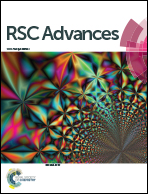Mode of inhibitory binding of epigallocatechin gallate to the ubiquitin-activating enzyme Uba1 via accelerated molecular dynamics†
Abstract
The green tea polyphenol (−)-epigallocatechin-3-gallate (EGCG) and some of its analogs potently inhibit the ubiquitin-activating enzyme Uba1. In an effort to understand the possible molecular basis of inhibitory activity of EGCG, we conducted a molecular docking and molecular dynamics simulation study. We found that EGCG and its two selected analogs, (−)-epicatechin-3-gallate (ECG) and (−)-epigallocatechin (EGC), bind favorably at two likely hot spots for small-molecule ligand binding on human Uba1. The compounds bind with energetics that mirror their experimental potency for inhibition of Uba1∼ubiquitin thioester formation. The binding of EGCG, ECG, and EGC at one of the hot spots, in particular, recapitulates the rank order of potency determined experimentally and suggests a possible mechanism for inhibition. A hinge-like conformational change of the second catalytic cysteine domain and the opposing ubiquitin-fold domain observed during accelerated molecular dynamics simulations of the EGCG-bound Uba1 complex that results in disruption of the ubiquitin-binding interfaces could explain the compounds' inhibitory activity. These results shed light on the possible molecular mechanism of EGCG and related catechins in the inhibition of Uba1.



 Please wait while we load your content...
Please wait while we load your content...